I wrote another post about Science Hack Day 2013, except for the final presentation, so here we go!
Datasets available: http://sciencehackday.pbworks.com/w/page/24500475/Datasets
List of projects: http://sciencehackday.pbworks.com/w/page/69019453/sfhacks2013
Room packed for presentation time.

There are one-pager paper on the walls, of all the projects.


The winner project: Formicidael Opponent
Formicidael Opponent team is controlling ants, and using that data as input.

Congratulations to the team!

This is their one pager.

Project description:
Putting lasers on fishes- fishes care, but ants don't care!Formicidael Opponent team is controlling ants, and using that data as input.
Presentation video:

Congratulations to the team!

This is their one pager.

Project description:
Our team has put together a system for testing stimuli on various organisms that can be bounded to a plane. Nothing that moves too much on the z axis. Our current design has been tested on ants and fish.
An arm capable of moving across the holding pen can be fitted with several end effectors. Laser pointer, rubber nudger, air puffer, ultrasonic clicker, etc.
The arm can be programmed to follow various patterns like spiral in/out and lawnmower/pushbroom in order to blindly stimulate the region of interest. In this manner we can begin to study the biologies interaction to the stimulus and build out a correlative understanding.
Cameras linked to computers doing blob tracking [or frame differencing] on the organisms are used to create an unbiased data set for statistical analysis on the organisms carrot/stick relationship with the stimulus.
Once reliable controls over the biology have been established games can be played.


Hacked 3D printer for getting ant data


People's choice & best use of data award: Symphony of the Satellites
Symphony of Satellites is an app that generates music based on the trajectories of satellites overhead based on your current location.
Presentation video:
One pager:
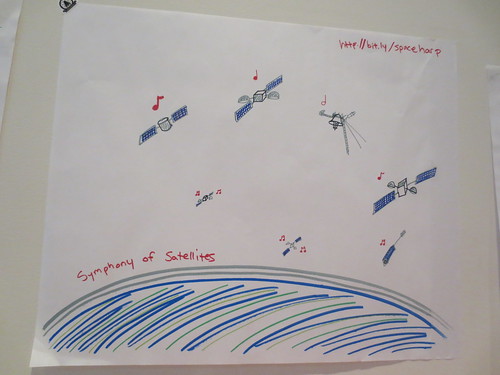
Symphony of Satellites is an app that generates music based on the trajectories of satellites overhead based on your current location.
Presentation video:
One pager:

Symphony of Satellites is an app that generates music based on the trajectories of satellites overhead based on your current location. Satellites above the horizon according to your coordinates make music between their rise and set. The velocity of satellite, its elevation, and other aspects of its trajectory determine the instrument, pitch, and rhythm of notes generated by that satellite, and the visualization on the page.
Can you hear the music of the spheres? Could it be that you've heard them your whole life?
Best Hardware Award: XYZZY
XYZZY team implemented an algorithm for real time audio source localization, and displayed it on colorful strip of LEDs, which are controlled by Arduino.
XYZZY team implemented an algorithm for real time audio source localization, and displayed it on colorful strip of LEDs, which are controlled by Arduino.
I wanted to have a portable microphone array, so that I could experiment with, and use, fun things like source localization, beamforming, and multichannel audio recording -- so I built one. The array is made out of PVC pipe, with omnidirectional reference microphones attached with buret clamps.
As a first experiment, I implemented an algorithm for real time audio source localization. The result of the localization can be seen on my laptop screen, and also on a colorful strip of LEDs, which are controlled by an attached arduino. The algorithm estimates a function I've dubbed "spatial power", which represents for any given frame of audio, how much power in that frame came from any location in the specified search space. Offline computation has demonstrated a very high degree of both spatial and temporal accuracy (<1cm @ 2m & <10ms), though my "rough" real time implementation does not yet match this.
In short, what this does is use the sound of an object, and ONLY the sound, to locate exactly WHERE the sound originated by looking at relative delays between microphone pairs, and mapping these delays (using the speed of sound) onto a spatial coordinate.

Best Design Award: Nagelier
Fitbits are nice, but you don't usually check the website. Nagalier team made a chandelier to hang in their rooms, and nag if your activity levels are low by changing the colors.

Fitbits are nice, but you don't usually check the website. Nagalier team made a chandelier to hang in their rooms, and nag if your activity levels are low by changing the colors.

Wearable devices like Fitbit allow us to record our steps and activity level, but to access the data and get motivated, you have to constantly check the Fitbit website or look at the device itself, which is often hidden under garments. We want our household environment to respond to our activity level, giving us the accountability to stay motivated.
If your lamp starts flashing red, it's time to get out of bed and go for a walk. If you're making good progress toward your goals, the light displays colors indicating your progress. And when you reach your step goal for the day, you're rewarded with a rainbow color display.

Best Entertainment Award: Cards Against Science
A variant of the adult party game, Cards Against Humanity.

A variant of the adult party game, Cards Against Humanity.

A variant of the adult party game, Cards Against Humanity, made possible by the CC-BY-NC license of the original game. The set of cards is now available for free download at www.cardsagainstscience.com
Best Communication Award: Journal of Brief Ideas
Journal of Brief Ideas is an open access forum for ideas, each limited in length. The communication form is rapid, brief, and open, and allows for the publication of partial results, small results, and null results.
Journal of Brief Ideas is an open access forum for ideas, each limited in length. The communication form is rapid, brief, and open, and allows for the publication of partial results, small results, and null results.

To solve some outstanding problems in scientific culture and publishing, we propose a Journal of Brief Ideas as an open access forum for ideas, each limited in length. The communication form is rapid, brief, and open, and allows for the publication of partial results, small results, and null results.Hack URL: briefideas.org
Rather than having ideas tied up in people's heads for many years, contributing only to an inefficiency in science, why not get them out in an attributable, citeable way so people can better spread information in a way that they can also claim credit for them?
Built on the figshare platform, the journal will allow for the rapid, open exchange of scientific ideas and results.

Best Education Award: Turn-key Cloud Chamber
A cloud chamber allows you to see radiation such as alpha and beta particles. Most set ups would use dry ice as the cold source to supersaturate the alcohol but they attempted to use a solid state device called a peltier.

A cloud chamber allows you to see radiation such as alpha and beta particles. In the chamber, there is a supersaturated layer of alcohol at the bottom and particles that pass through ionizes the air and the surrounding alcohol mist condenses. Most set ups would use dry ice as the cold source to supersaturate the alcohol but we attempted to use a solid state device called a peltier. However, dry ice is not reusable and not easily transportable. By putting a voltage across the peltiers, one side becomes very warm and the other side becomes very cold so we used this property to cool our chamber. This novel idea allows us to view elementary particles in a portable set up.
Pand-AIR-o is a tambourine-like musical instrument using Leap motion.

This hack was inspired by the Brazilian hand drum called the pandeiro. It looks like a tambourine, and is played by hitting the drum head with different the palm and fingers at different locations. We tried to represent this playing experience by programming the Leap device to make the sounds a pandeiro makes - at least for 3 types of 'hits'. The hack samples real pandeiro audio clips that are triggered by the appropriate hand gestures. At the current stage, we can play a basic samba rhythm pattern. Let's dance!
Judges Would Like to Own Award: Personal Planetarium
A portable planetarium, just for yourself....
A portable planetarium, just for yourself....
Bio Award: rEcomons
Wearable ecological monitors that we can take in to the field to measure parameters such as temperature, humidity, luminosity (light), and GPS location.
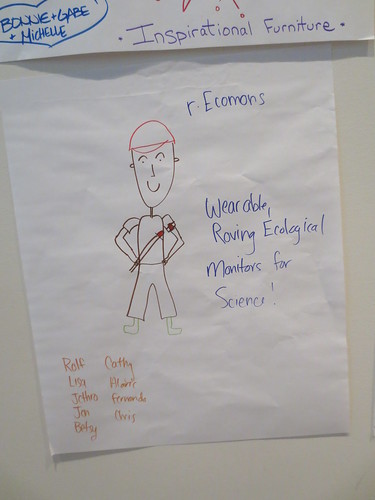
Wearable ecological monitors that we can take in to the field to measure parameters such as temperature, humidity, luminosity (light), and GPS location.

We made up some wearable ecological monitors that we can take in to the field to measure parameters such as temperature, humidity, luminosity (light), and GPS location. This is so that we can explore the world around us, as laymen and professional scientists, on the cheap! (<$50) Wowza, and it posts all of these datums to the internetz in real time! In our future, we'll deploy an army of robo-cats, cats, and robots that act like cats with these rEcomons devices. Beware collectible datums, ur base r belong to us!





Most Dangerous Award: DIY Lava
Exploring a cheap, easy way to melt rock.
Exploring a cheap, easy way to melt rock.

Our goal was to find a cheap, easy way for geoscience educators to melt rock, thereby enabling students to see key geologic priniciples for themselves, rather than accept them on faith. Oh yeah, and for students to experience the sheer thrill of SEEING REAL MOLTEN ROCK. : )


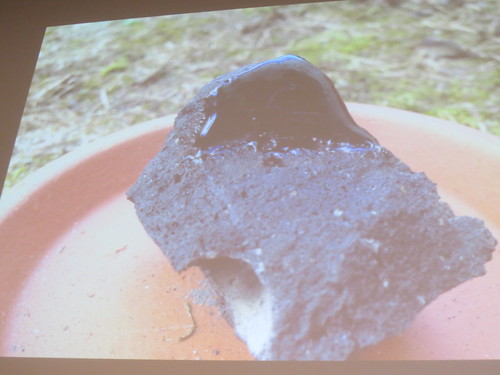


Best Application Award: driven by efficiency
A mobile app that calculates and displays the "hidden" cost of gas per gallon based on real-time accelerometer data, and encourages users to drive less aggressively and more fuel-efficiently by using real time data and social pressure.
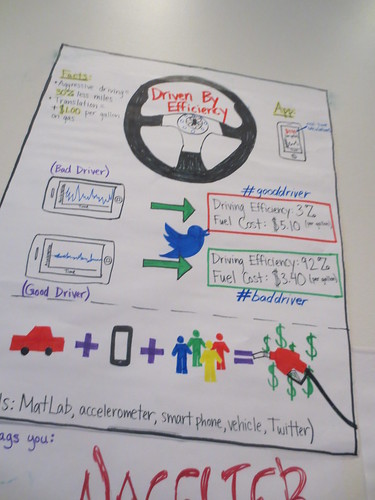
"Driven By Efficiency" is a mobile application that encourages users to drive less aggressively and more fuel-efficiently by using real time data and social pressure. More specifically, the application calculates and displays the "hidden" cost of gas per gallon based on real-time accelerometer data. Driver defensiveness is also calculated based on a scale from 0% - 100%, automatically posting this information to the user's Twitter account after each driving session (i.e. "John Smith is currently driving worse than 70% of drivers on the road.")



Please Keep Going Award: 3D Printing Sea Slugs
A cheap and easy system to 3D image nudibranchs (sea slugs) that will allow accurate measurements of shape underwater and sluggy and to 3D print them.
A cheap and easy system to 3D image nudibranchs (sea slugs) that will allow accurate measurements of shape underwater and sluggy and to 3D print them.
I'm working to create a cheap and easy system to 3D image nudibranchs (sea slugs) that will allow accurate measurements of shape (and to 3D print them). This technology will be used for researchers to take and use in the field.
Tried out and brainstormed various ideas using photographs, lasers, 123D catch, in-water and out of water iphone burst capture photographs, live and preserved slugs and salt and freshwater. So far, the only results were from out of water, preserved slugs using 123D catch.
Why?My graduate research involves measuring the hyperbolic geometry of nudibranchs, and comparing that to the different types of chemical defense toxins stored along the edge of their bodies (these sea slugs steal and reuse these chemicals from their prey!) to see if their unique shape can act as a predictor of the toxicity of the slugs. Practical applications? Well a lot of these chemicals have biomedical properties and are being examined in cancer and HIV research. Also, slugs are just plain cool.







Young Scientist Award: Darwin, the Poet
Analyzing evolution of letters, words, sentences...
Analyzing evolution of letters, words, sentences...
-Punkulele

Robotic ukulele! Servo-controlled picks actuate the strings, driven by a Teenyduino 2.0. Further details to come on our web page. :)

-Text Evolution

How does DNA transcription with it's error correction mechanisms work? Here we model the process by using sentences and words as the DNA strings, allowing point mutations and insertion and deletion mutations. The DNA error checking process is modeled by a spell check and the repair mechanism by the suggested best match to misspelled words. The process shows the impact of mutations on a text over time, especially in terms of the particularly harsh effect of insertion and deletion mutations.
-Radio Free Earth
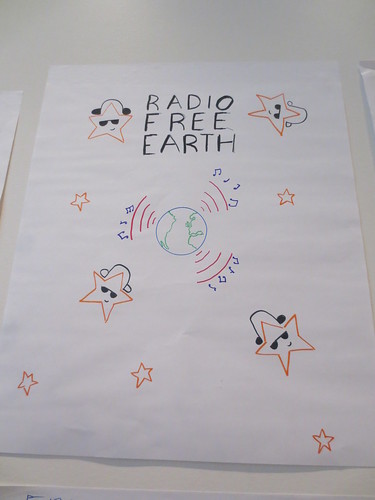
The radiosphere of planet Earth extends about 70 light years outwards. Stars within this boundary have received radio and television transmissions from earth.
Find out which number one hits have reached which stars ...using Radio Free Earth!

-LHC Data Conversion


The particle physics community is confronting two related issues: how to preserve our data for future generations/studies and how to make our data more available for educational purposes or just interested hackers. We currently use an open-source, but in-house-written analysis software package called ROOT (http://root.cern.ch/drupal/) that has it's own data format defined. Some of us would like to put samples of our data in more widely used formats for others to use and we have in fact done that! You can download CMS data in .csv or .json data files.
But those formats are basically text and therefore are big files and can be slow to read when you want a student to work with 10's of GB of data. I would like to put some sample data in the HDF5 format. (http://www.hdfgroup.org/HDF5/) It is a binary format being used more and more in the Big Data scientific community. There are some very nice python tools to interface with it (http://www.h5py.org/) and it seems a natural file format to try.
Instead of running this on particle physics data, which is difficult to explain, I created a mock dataset of information about 1000 families (# parents, # children, pets, etc.) which mirrors many of the challenges of the physics data.
We worked together to build a test case comparing ease of use and speed of access for text files, ROOT files, and HDF5. We didn't get all the way there, but we did get the process started!
-Synchrotron Status Viewer

Synchrotron light sources are particle accelerators used by a variety of scientists. We created visual database implemented as a web app for potential synchrotron users to get information about synchrotrons.



-Birdwatch
We built a app to illustrate the stationary and migratory areas of individual birds. Want to allow individuals to track their favorite birds, and ultimately get notifications when their choices arrive in their area. They can actively move through maps showing bird habitat areas, seeing local and broad patterns.
We managed to put together a demonstration with a single bird that illustrates the concept. This allowed us to learn how create javascript annotated maps, serve a tablet version with herok. Everyone learned learned new tools, and has an example with working components. The next goal is to leverage bird data achives including links with both large organizational data and citizen data.


-Final Runtier

Inspired by a love of running and the California Academy of Sciences' planetarium show, the Final Runtier mobile app allows users to turn their jogs into journeys in space, challenging them to not only run farther but also to imagine the vastness of the universe. Jog in miles, travel in lightyears—the Final Runtier: Where no run has gone before.
—Compare jogged Earth miles to astronomical units & lightyears—Challenge yourself to achieve new astronomical milestones and comprehend the massive scale of the universe—Challenge friends to catch up with your journeys!
(The prototype is an iOS app, but other mobile platforms will be developed as well.)


-Science Box


Science Box is a self-sterilizing cleanbox with temperature and humidity control. This is a suite of a few basic lab tools all shoved into a box that is about 50% the size of a standard Minecraft block.

Using USGS's live earthquake feed, we match the recent earthquake locations to your Facebook friends that are near these earthquakes, and provide a notification system for you about friends that might be at risk.

-Look. Render. Leap.

The goal of this hack is to take data exported from yt (yt-project.org) and load up a 3D dataset in a web-browser and interact with it using the Leap Motion software/hardware (https://www.leapmotion.com/). To do so, we exported a fixed resolution 3D cube using N images of size NxN. After loading this into three.js PlaneGeometry meshes, we then render them using three.js's backend WebGL renderer.
For interaction, we set up a simple camera navigation where a user grabs the cube, can drag it around, and optionally add an opaque plane that can be positioned anywhere along the z-axis of the data. In this way a user can explore (in this first case) the temperature structure of a cosmological simulation run with Enzo (enzo-project.org).
The hope for the future is to be able to dynamically re-sample data using a more direct python<->Javascript interface to send instructions and data back and forth.



Video: http://www.youtube.com/watch?v=JXj6Ekdm9_w&feature=youtu.be
-SolarLEAP

We used the Leap MOTION (www.leapmotion.com) device to control a basic walkthrough of the lifecycle of a star. The LEAP allows the user to resize the star using both hands and walk forward and backward through the lifecycle by using the LEAP's predefined circle gesture (waving your finger over the device in a circle).Hack URL: http://solarflare.neocities.org/star.html

-HPCGUI

We use High Performance Computing systems (http://www.nersc.gov/systems/hopper-cray-xe6/) to run calculations for quantum physics/materials science (http://www.quantum-espresso.org). Users can trigger the calculations and analyze/visualize the data from within the web browser.

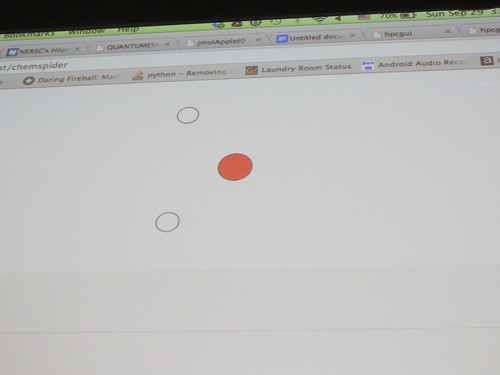
-Open Data Licensing

Open data are "open", but do their licenses reflect that? I downloaded the metadata files about all of the datasets on 102 open data portals hosted on CKAN, Socrata and OpenDataSoft software. Each of these data portal softwares has a metadata field for the license of each particular dataset. And then I looked at what the licenses were. As we should expect, a lot of datasets have standard open licenses. But not all.
-Attention!
Attention! Explore. Play. Learn. EEG provides a possibility for quantatative analsyis of brain activity during the cognitive act of attending to different spatial areas of the body.
Several years ago a respected colleague in neuroscience cited some unpublished research which suggested the capacity to pick up spatial disparities in activity on his scalp which correlated to differential topographic changes in spatially directed attention.
Moving attention around spatially during meditation is useful as a practice and actually dates back to ancient times.
To dig into this, we took two types of off the shelf EEG hardware, wrote code to collect data and analyzed results of a few experiments.
We found it difficult to discriminate right and left attention signals, but more work is left to be done. A further exploration we played with a bit was a sensory regime incorporating flashing LEDs on closed eyelids.



-Citizen Science Resource Book

Citizen scientists sometimes have trouble disseminating their work to peers and the general populous. Citizen scientists often find that conventional science journals are inconvenient places to publish their work; journals can have undesirable licensing, they can be slow to publish, and they can be expensive. There are many other places where people may choose to disseminate their discoveries, but many people are not aware of these places. This is why we are writing this book about how to communicate to the external world the discoveries and experiments conducted by citizen scientists.
We consider it imperative that scientific research, of all kinds, be easily accessible by professionals and laymen alike. As well, that there be some sort of portal for these people to communicate their ideas to one another. Scientific research and inquiry no longer must be limited to the privileged few, but can be made freely available and accessible to most people.
-Biohacking Web Widgets

The beginnings of a GUI widget library written in html5/css/js. Currently it contains a nearly completed plasmid viewer and a work in progress sequence editor.
The plasmid viewer can show plasmids, with multiple layers over overlapping annotated genetic features. This is useful when choosing and designing the plasmid cloning vector for getting constructed DNA into a target organism. A few bugs remain in the automatic placement of the annotation labels.
We didn't quite complete the sequence editor, but the idea is that it's a custom text editor where the text is limited to G, T, A and C, and the letters are visually grouped into groups of three (codons). Currently you can type, copy and paste sequences. Planned features include showing the complimentary strand and showing different colors for either single nucleotides or codons.

-SwingSynth
Miniature aerial swing generates variable voltage input through a load cell to an arduino, where it is then converted to midi output and connected to a synthesizer to create music (and other output) from motion.


-Indirect Measurement and 2D Mapping of Chlorophyll in Sediment

This hack is to find a cheap and specific method for chlorophyll, or other fluorescing molecule, identification via laser excited fluorescence. While this is only a theoretical hack we believed it to be an interesting solution to the problem. Because the resulting fluorescence from laser excitation in the field is likely to be incredibly dim and would require a very expensive sensor we propose that the fluorescence emission be measured by its ability to distort a periodic radio wave from a nearby source. The resulting distortion could be identified in 2D space providing a rough map of the radio wave sensor area positioned at the source of the laser.

-Essential oil extraction


Steam extraction of essential oils from rosemary and tangerine peels, using a cooking pot with inverted lid.



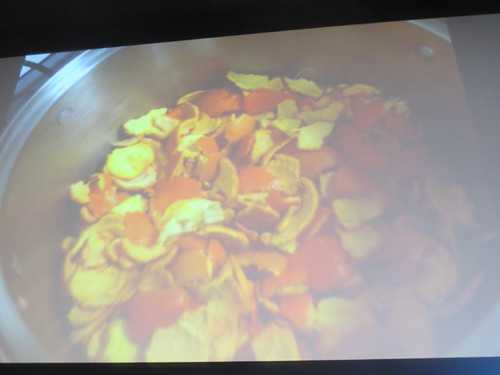

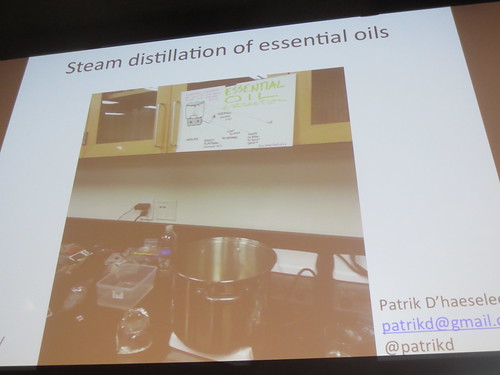
-Heart in a Jar
Decellularization of a pig heart. The frozen pig heart we got had too much of its "plumbing" removed for us to be able to do the full retrograde perfusion, but we experimented with degradation of pig heart slizes using digestive enzymes (papayin, bromelain, pancreatin) and bile acid.



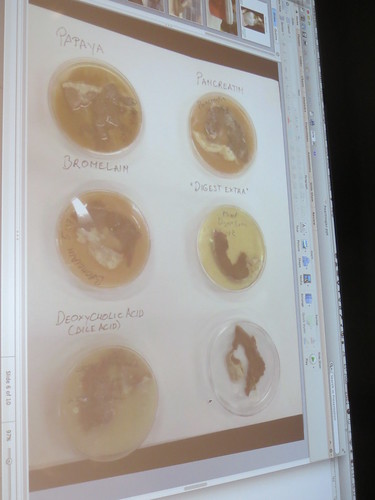
==========================================







"SCIENCE!! "

Video from the livestream of the final presentation:
Video streaming by Ustream
Other blogs:
Summarizing Science Hack Day SF 2013
Science Hack Day 2013: A Beginner’s Tale
Disclaimer: The opinions expressed here are my own, and do not reflect those of my employer. -Fumi Yamazaki


















0 件のコメント:
コメントを投稿